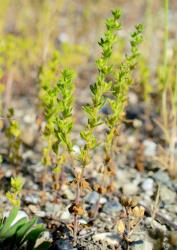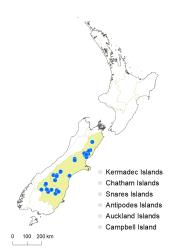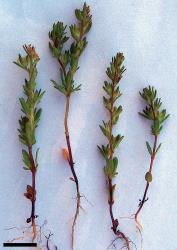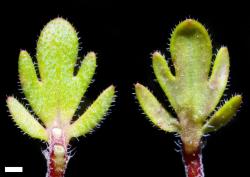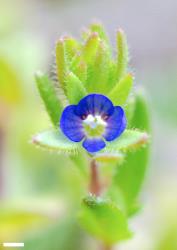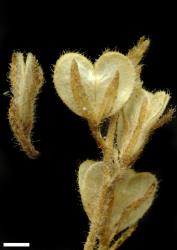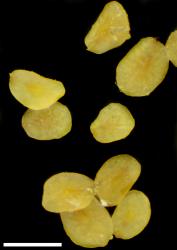Annual herb to 0.25 m tall. Stems erect, sometimes ascending at base, uniformly eglandular-hairy below, becoming glandular-hairy above. Leaf bud indistinct; leaves separating while very small, opposite-decussate, erecto-patent to spreading; lamina thin, lanceolate to ovate to elliptic to deltoid in outline, deeply pinnatifid in 3–7 lobes, 3–15 mm long, 2–12 mm wide, dull green above and beneath; midrib and lateral veins visible; surfaces and margins with scattered, long eglandular hairs, and also some glandular hairs especially on upper leaves; stomata not visible; margin of lobes entire or distantly and shallowly crenate or serrate; apex obtuse to acute; base cuneate or abruptly cuneate; petiole 0–1.5 mm long. Inflorescence a terminal raceme, 10–150 mm long; flowers crowded at first, becoming more distant at fruiting, 2–100, all bisexual; bracts alternate, the lower deltoid and deeply pinnatifid, the uppermost becoming simple, linear, > pedicels; pedicels erect to erecto-patent, 1.0–1.5 mm long, mixed eglandular- and glandular-hairy all around. Calyx lobes 4, acute, 1.5–2.5 mm long, unequal, mixed eglandular- and glandular-hairy. Corolla 1.0–1.5 mm diameter; tube white and usually somewhat greenish-yellow, 0.5–0.6 mm long, < calyx, sparsely eglandular-hairy inside; lobes 4, blue, erect to erecto-patent, sub-equal, elliptic, 0.8–1.2 mm long, obtuse; nectar guides dark blue. Stamen filaments white, 0.4–0.6 mm long; anthers blue. Style glabrous, 0.3–0.5 mm long. Capsules angustiseptate, obcordate, eglandular-hairy on faces and glandular as well near margins, 2.5–3.2 mm long, 3.2–4.2 mm at widest point. Seeds elliptic to obovoid, flattened, smooth, straw-yellow to pale brown, 0.9–1.2 mm long.
V. verna is one of several similar species. Plants are most likely to be misidentified as V. arvensis, which is characterised by a similar growth form and overall appearance. However, V. arvensis plants are less strictly erect, have different stem hairs (short, bifarious eglandular hairs and long, uniform eglandular hairs), upper leaves and bracts toothed but never pinnatifid, and capsules glabrous on their faces with long, fringing, marginal glandular or eglandular hairs.
V. triphyllos plants have pinnatifid stem leaves and bracts, but differ in habit (decumbent to ascending), leaf lobes that are broader and more rounded, larger flowers (4–6 mm diameter) and fruits (3–5 × 4–6 mm), and cup-shaped dark seeds.
South Island: Marlborough (Molesworth), Canterbury, Otago.
Dry, inland sites such as pasture and arable crops, river terraces, waste land, roadsides. Recorded elevations range from 10 to 862 m.
Allan (1940, p. 303). Voucher not cited, but “noted at Fairlie”.
Indigenous to temperate Eurasia and North Africa.
Flowers: September–November (rarely extending to January); fruits: October–December (occasionally to January).
2n = 16 from overseas material (Albach et al. 2008).
Veronica verna is classified in V. subg. Chamaedrys (Albach et al. 2004; Albach & Meudt 2010).
The hairs on the lower part of the stems are short, eglandular, and antrorse. Longer-spreading glandular hairs become common in the flowering portion, especially above.



